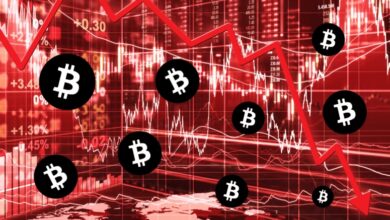Bitcoin vs Gold: A Store of Value Showdown Amidst Price Volatility

Bitcoin, the leading cryptocurrency, has experienced a significant drop in prices recently, reaching its lowest levels since mid-March. However, despite this price volatility, Bitcoin continues to exhibit its store of value properties, outperforming gold by a substantial margin this year. On-chain analytics firm Glassnode has been comparing Bitcoin prices with gold prices, revealing that Bitcoin’s spot price now equates to 13.3 ounces of gold, marking a year-to-date increase of 46%. Let’s delve into the battle between Bitcoin and gold as store of value assets and examine their performance amidst market fluctuations.
Bitcoin’s Stellar Performance:
Bitcoin’s impressive performance as a store of value becomes evident when considering its substantial outperformance of gold. Since the COVID-19 low in March 2020, Bitcoin has surpassed gold by a staggering margin of approximately 430%. Even in the year 2023 alone, Bitcoin’s value has surged by 51.6%, doubling its price if measured against its peak in mid-April.
Gold’s Steady Growth:
While Bitcoin has been on a roller-coaster ride, gold has demonstrated a more steady growth pattern. Comparatively, gold prices have increased by a modest 6.2% since the beginning of the year. Currently trading at $1,940 per ounce, gold has experienced a 5% decline from its all-time high of $2,040 per ounce in mid-April.
Volatility vs. Stability:
Both Bitcoin and gold hold their positions as excellent stores of value and safe havens. Gold represents stability, with its slow and steady growth over time. On the other hand, Bitcoin’s volatility has been more pronounced, particularly evident in its 63.7% decline from its all-time high of $69,000 in November 2021. Despite this, the data suggests that Bitcoin retains its status as a store of value, proving its resilience in the face of market fluctuations.
The Impact of Inflation:
Another crucial factor to consider when assessing stores of value is the impact of inflation. Over the past few years, the U.S. dollar has experienced significant devaluation due to high levels of inflation. Cumulative inflation from 1956 to 2022 stands at an astonishing 976%, meaning that the purchasing power of $100 from back then is equivalent to almost $1,000 today. Currently, inflation in America is at 4%, a decrease from over 9% recorded at the same time last year, partly due to Federal Reserve interest rate hikes.
Bitcoin’s Reaction to Market Events:
Recent market events, including the U.S. Federal Reserve’s announcement to pause rate hikes and the ongoing regulatory scrutiny of cryptocurrencies in the United States, have impacted Bitcoin’s performance. In response to the Fed’s announcement and negative market sentiment, Bitcoin prices dropped to a three-month low of $24,879 on June 15. Although the asset has recovered slightly to hover just above $25,000 at the time of writing, it remains in a bearish state.
Conclusion:
Bitcoin and gold continue to be regarded as reliable stores of value despite their contrasting characteristics. Bitcoin’s price volatility does not diminish its appeal as a long-term investment option, as it has consistently outperformed gold by a significant margin. Meanwhile, gold’s stability and resilience make it an attractive asset for those seeking a more predictable store of value. The ongoing battle between Bitcoin and gold underscores the diverse investment choices available to individuals looking to preserve and grow their wealth amidst market fluctuations and the impact of inflation.

